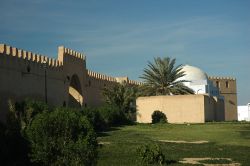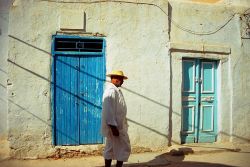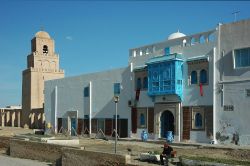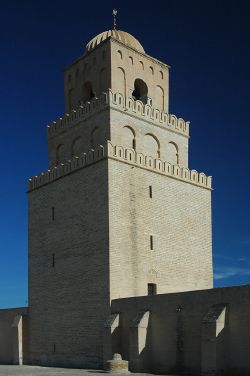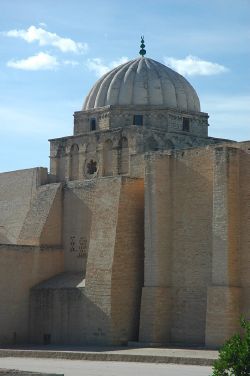Difference between revisions of "Kairouan" - New World Encyclopedia
Mike Butler (talk | contribs) |
Mike Butler (talk | contribs) |
||
| Line 11: | Line 11: | ||
| Link = http://whc.unesco.org/en/list/499 | | Link = http://whc.unesco.org/en/list/499 | ||
}} | }} | ||
| − | '''Kairouan''' ([[Arabic language|Arabic]] القيروان) (also known as '''Kirwan''', '''Al Qayrawan''') is a [[Muslim]] holy city which ranks after [[Mecca]] and [[Medina]] as a place of pilgrimage,<ref>{{cite book | + | '''Kairouan''' ([[Arabic language|Arabic]] القيروان) (also known as '''Kirwan''', and '''Al Qayrawan''') is a [[Muslim]] holy city which ranks after [[Mecca]] and [[Medina]] as a place of pilgrimage,<ref>{{cite book |
| title = Hutchinson Encyclopedia 1996 Edition | | title = Hutchinson Encyclopedia 1996 Edition | ||
| publisher = Helicon Publishing Ltd, [[Oxford]] | | publisher = Helicon Publishing Ltd, [[Oxford]] | ||
| Line 18: | Line 18: | ||
| doi = | | doi = | ||
| isbn = 1-85986-107-5}}</ref> particularly for [[sufi]]s.{{Fact|date=November 2008}} Located in [[Tunisia]], about 160 kilometres south of [[Tunis]], Kairouan was founded by the [[Arabs]] in around [[670]]. | | isbn = 1-85986-107-5}}</ref> particularly for [[sufi]]s.{{Fact|date=November 2008}} Located in [[Tunisia]], about 160 kilometres south of [[Tunis]], Kairouan was founded by the [[Arabs]] in around [[670]]. | ||
| − | |||
| − | |||
==Geography== | ==Geography== | ||
[[Image:TUNISIE_KAIROUAN_03.jpg|thumb|left|250px|Fortifications against past foes.]] | [[Image:TUNISIE_KAIROUAN_03.jpg|thumb|left|250px|Fortifications against past foes.]] | ||
| − | The original name was derived from [[Arabic]] ''kairuwân'', meaning "camp", "caravan", or "resting place". | + | The original name was derived from the [[Arabic]] word ''kairuwân'', meaning "camp", "caravan", or "resting place". |
Kairouan is located on the Low Steppes area of Tunisia, a semi-arid alluvial plain southeast of the Central Tell, at an elevation of 223 feet (68 meters). | Kairouan is located on the Low Steppes area of Tunisia, a semi-arid alluvial plain southeast of the Central Tell, at an elevation of 223 feet (68 meters). | ||
| Line 29: | Line 27: | ||
Kairouan has a semi-arid Mediterranean climate, with hot summers and mild winters, when there is more rainfall. Best periods are spring and autumn. The average maximum daytime temperature in January is 63.5°F (17.5°C), rising to an average maximum of around 99.5°F (37.5°C) in July. Mean annual precipitation is 12.1 inches (309mm). | Kairouan has a semi-arid Mediterranean climate, with hot summers and mild winters, when there is more rainfall. Best periods are spring and autumn. The average maximum daytime temperature in January is 63.5°F (17.5°C), rising to an average maximum of around 99.5°F (37.5°C) in July. Mean annual precipitation is 12.1 inches (309mm). | ||
| − | Environmental issues include health risks posed by ineffective toxic and hazardous waste disposal, water pollution from raw sewage, and limited natural fresh water | + | Environmental issues include health risks posed by ineffective toxic and hazardous waste disposal, water pollution from raw sewage, and limited natural fresh water. |
To protect Kairouan city against flooding from Wadi Merguellil, the El Haouareb dam was constructed in 1989. | To protect Kairouan city against flooding from Wadi Merguellil, the El Haouareb dam was constructed in 1989. | ||
| Line 38: | Line 36: | ||
[[Image:Kairouan-scene-de-rue.jpg|thumb|right|250px|Kairouan street scene.]] | [[Image:Kairouan-scene-de-rue.jpg|thumb|right|250px|Kairouan street scene.]] | ||
[[Image:TUNISIE_KAIROUAN_01.jpg|thumb|right|250px|Ancient sun-baked buildings.]] | [[Image:TUNISIE_KAIROUAN_01.jpg|thumb|right|250px|Ancient sun-baked buildings.]] | ||
| − | Kairouan was founded in about the year 670 when the [[Arab]] [[Umayyad]] general [[Uqba ibn Nafi]] (622–683) selected a site in the middle of a dense forest, then | + | Kairouan was founded in about the year 670, when the [[Arab]] [[Umayyad]] general [[Uqba ibn Nafi]] (622–683) selected a site in the middle of a dense forest, then full of wild beasts and reptiles, as a base for military operations, and far enough from the sea where it was safe from continued attacks of the [[Berber people|Berber]]s who had fiercely resisted the Arab invasion. |
In 745 [[Kharijite]] [[Berbers]] captured Kairouan, which was by that time a developed city with luxuriant gardens and olive groves. | In 745 [[Kharijite]] [[Berbers]] captured Kairouan, which was by that time a developed city with luxuriant gardens and olive groves. | ||
| − | Power struggles continued until [[Ibrahim ibn al-Aghlab]] (756-812) recaptured Kairouan at the end of the eighth century. In 800, Ibrahim was confirmed [[Emir]] and hereditary ruler of [[Ifriqiya]], the area comprising the coastal regions of what | + | Power struggles continued until [[Ibrahim ibn al-Aghlab]] (756-812) recaptured Kairouan at the end of the eighth century. In 800, Ibrahim was confirmed [[Emir]] and hereditary ruler of [[Ifriqiya]], the area comprising the coastal regions of what became western [[Libya]], [[Tunisia]], and eastern [[Algeria]], by the [[Caliph]] in [[Baghdad]]. His [[Aghlabite]] dynasty ruled [[Ifriqiya]] between 800 and 909. The new emirs made Kairouan famous for levels of prosperity reaching those of [[Basra]] and [[Kufa]] and giving Tunisia one of its golden ages. |
The [[Aghlabite]]s built the great mosque and established in it a university that was a centre of education both in Islamic thought and in the secular sciences. In the ninth century, the city attracting scholars from all over the [[Islamic World]]. In that period [[Imam]] [[Sahnun]] (776–854) and [[Asad ibn al-Furat]] (759-828) made Kairouan a temple of knowledge. The [[Aghlabite]]s built palaces, fortifications and fine waterworks of which only the pools remain. The [[Aghlabite]]s conquered Sicily in 827. | The [[Aghlabite]]s built the great mosque and established in it a university that was a centre of education both in Islamic thought and in the secular sciences. In the ninth century, the city attracting scholars from all over the [[Islamic World]]. In that period [[Imam]] [[Sahnun]] (776–854) and [[Asad ibn al-Furat]] (759-828) made Kairouan a temple of knowledge. The [[Aghlabite]]s built palaces, fortifications and fine waterworks of which only the pools remain. The [[Aghlabite]]s conquered Sicily in 827. | ||
Revision as of 02:03, 8 December 2008
| Kairouan* | |
|---|---|
| UNESCO World Heritage Site | |
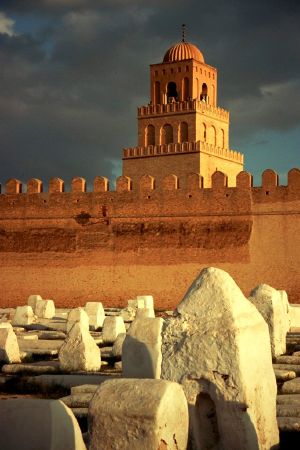
| |
| State Party | |
| Type | Cultural |
| Criteria | i, ii, iii, v, vi |
| Reference | 499 |
| Region** | Arab States |
| Inscription history | |
| Inscription | 1988 (12th Session) |
| * Name as inscribed on World Heritage List. ** Region as classified by UNESCO. | |
Kairouan (Arabic القيروان) (also known as Kirwan, and Al Qayrawan) is a Muslim holy city which ranks after Mecca and Medina as a place of pilgrimage,[1] particularly for sufis.[citation needed] Located in Tunisia, about 160 kilometres south of Tunis, Kairouan was founded by the Arabs in around 670.
Geography
The original name was derived from the Arabic word kairuwân, meaning "camp", "caravan", or "resting place".
Kairouan is located on the Low Steppes area of Tunisia, a semi-arid alluvial plain southeast of the Central Tell, at an elevation of 223 feet (68 meters).
Kairouan has a semi-arid Mediterranean climate, with hot summers and mild winters, when there is more rainfall. Best periods are spring and autumn. The average maximum daytime temperature in January is 63.5°F (17.5°C), rising to an average maximum of around 99.5°F (37.5°C) in July. Mean annual precipitation is 12.1 inches (309mm).
Environmental issues include health risks posed by ineffective toxic and hazardous waste disposal, water pollution from raw sewage, and limited natural fresh water.
To protect Kairouan city against flooding from Wadi Merguellil, the El Haouareb dam was constructed in 1989.
History
Kairouan was founded in about the year 670, when the Arab Umayyad general Uqba ibn Nafi (622–683) selected a site in the middle of a dense forest, then full of wild beasts and reptiles, as a base for military operations, and far enough from the sea where it was safe from continued attacks of the Berbers who had fiercely resisted the Arab invasion.
In 745 Kharijite Berbers captured Kairouan, which was by that time a developed city with luxuriant gardens and olive groves.
Power struggles continued until Ibrahim ibn al-Aghlab (756-812) recaptured Kairouan at the end of the eighth century. In 800, Ibrahim was confirmed Emir and hereditary ruler of Ifriqiya, the area comprising the coastal regions of what became western Libya, Tunisia, and eastern Algeria, by the Caliph in Baghdad. His Aghlabite dynasty ruled Ifriqiya between 800 and 909. The new emirs made Kairouan famous for levels of prosperity reaching those of Basra and Kufa and giving Tunisia one of its golden ages.
The Aghlabites built the great mosque and established in it a university that was a centre of education both in Islamic thought and in the secular sciences. In the ninth century, the city attracting scholars from all over the Islamic World. In that period Imam Sahnun (776–854) and Asad ibn al-Furat (759-828) made Kairouan a temple of knowledge. The Aghlabites built palaces, fortifications and fine waterworks of which only the pools remain. The Aghlabites conquered Sicily in 827.
The Maliki school, which is is one of the four schools of religious law within Sunni Islam, emerged at Kairouan, as clerics challenged the personal and political excesses of the Aghlabid emirs.
In 893, Kutama Berbers from the west of the country started the Shiite Fatimid movement, which in 909 overthrew the Sunni Aghlabites that ruled Ifriqiya, creating the Shiite Fatimid dynasty. During the reign of the Fatimids, Kairouan was neglected and lost its importance as the new rulers resided first in Raqqada but soon moved their capital to the newly built Al Mahdiyah on the coast of modern Tunisia.
After succeeding in extending their rule over all of central Maghreb, an area consisting of the modern countries of Morocco, Algeria, Tunisia and Libya, they eventually moved west to Egypt to found Cairo making it the capital of their vast Califate and leaving the Zirids, a Kutama Berber dynasty, as their vassals in Ifriqiya.
Governing again from Kairouan, the Zirids led the country through another artistic, commercial and agricultural heyday. Schools and universities flourished, overseas trade in local manufactures and farm produce ran high and the courts of the Zirids rulers were centers of refinement that eclipsed those of their European contemporaries.
When the Zirids declared their independence from Cairo and their conversion to Sunni Islam in 1045 by giving allegiance to Baghdad, the Fatimid Caliph Ma'ad al-Mustansir Billah (1029–1094) sent as punishment hordes of troublesome Arab tribes (Banu Hilal and Banu Sulaym) to invade Ifriqiya.
Kairouan was destroyed in 1057. Nomadism spread in areas where agriculture had been dominant. With the rise of Tunis as capital, Kairouan declined into an isolated market town for nomads.
In 1881, Kairouan was taken by the French, after which non-Muslims were allowed access to the city.
Kairouan was proclaimed as Capital of Islamic Culture for 2009.
Government
Tunisia is a republic in which the president, who is chief of state, is elected by popular vote for a five-year term, and has no term limits. The prime minister, who is head of government, is appointed by the president. There is Chamber of Deputies, or Majlis al-Nuwaab, comprising 189 members elected by popular vote to serve five-year terms, and the Chamber of Advisors, comprising 126 seats of which 85 members are elected by municipal counselors, deputies, mayors, professional associations and trade unions, and 41 members are presidential appointees.
Kairouan is the capital of the Kairouan Governorate, which is one of Tunisia's 24 governorates, and which are divided into 262 districts (mutamadiyat), and further subdivided into delegations. There are 11 delegations in Kairouan, which are further divided into municipalities.
Economy
Tourism has made an impact on Kairouan since it was declared a World Heritage Site in 1988, most notably by providing a reason for the conservation of the old city and the development of the town’s Musée d’Art Islamique. According to statistics released in December 2008, Tunisia hosted during the 11 months of 2008 around 6.6 million tourists from all nationalities which is an increase of 3.7 percent compared to the previous year.
The establishment of a university, and of some light industry meant the town has expanded quickly.
Otherwise, the modern city trades in grain and livestock from the surrounding region, and exists as a center for carpet and handicrafts. A road and railway link Kairouan with Sousse, 38 miles (61km) to the east.
Demographics
Kairouan had about 150,000 inhabitants in 2003. Ninety eight percent of Tunisia's population were Arab, one percent were European, while Jewish and others totalled one percent. Arabic is the official language, and one of the languages of commerce, while French is used in commerce.
Muslims make up 98 percent of the population, Christians one percent, Jewish and other one percent. There are numerous mosques in Kairouan, including the great mosque. Judaism featured in Kairouan's history, particularly in the early Middle Ages. Rabbeinu Chananel (990-1053), who is best known for his commentary on the Talmud, was from Kairouan.
Kairouan university, established in 2004, had more than 3000 students enrolled in 2008.
Of interest
The Mosque of Uqba, also known as the Great Mosque of Kairouan, which has a 115-foot- (35-meter) high minaret, is one of the most important mosques in Tunisia. Built by Uqba ibn Nafi from 670 C.E. at the founding of the city of Kairouan, the mosque is spread over a surface area of 900 square metres and is considered as a model for all later mosques in the Maghreb in the western Islamic world. It largely consists of its original building materials. In fact most of the column stems and capitals were taken from ruins of earlier-period buildings, while others were produced locally. There are 414 columns in the mosque. Almost all were taken from the ruins of Carthage. Previously, it was forbidden to count them, on pain of blinding.[2] Other sites of interest include:
- The souk (market place) of Kairouan is in the Medina quarter, which is surrounded by walls, from which the entrance gates can be seen in the distance. Products that are sold in the souk include carpets, vases and goods made of leather. As with merchants in most major Tunisian cities, Kairouan merchants rely on tourism for much of their income.
- The seat of the religious fraternity of Sīdī Sahab, which contains the tomb of one of the companions of Muhammad, located near the town.
- An Aghlabid reservoir, an open circular pool 420 feet (128 metres) in diameter, which dates from the ninth century.
Among Tunisians, Kairouan is known for its pastries — zlebia and makroudh. In the action movie Raiders of the Lost Ark, the street scenes in "Cairo" were filmed in Kairouan.
Footnotes
- ↑ (1996) Hutchinson Encyclopedia 1996 Edition. Helicon Publishing Ltd, Oxford, pg.572. ISBN 1-85986-107-5.
- ↑ Mooney, Julie (2004). Ripley's Believe It or Not! Encyclopedia of the Bizarre: Amazing, Strange, Inexplicable, Weird and All True!. New York: Black Dog & Leventhal Publishers. ISBN 1579123996.
Further reading
- Armes, William Dallam. 1915. The African Mecca; the holy city of Kairouan. Berkeley: University of California Press. OCLC 30001203
- Maoudoud, Khaled. 1992. Kairouan: history of the city and its monuments. [Tunis]: National Heritage Agency. ISBN 9789973917065
- Office national du tourisme tunisien. 1984. Tunisia: Kairouan. Tunis?: Tunisian National Tourist Office. OCLC 55479562
- Petrie, Graham. 1908. Tunis, Kairouan & Carthage. London: W. Heinemann. OCLC 412710
- Sebag, Paul, and André Martin. 1965. The Great Mosque of Kairouan. London: Collier-Macmillan. OCLC 1122988
External links
- World Fact Book 2008 Tunisia Retrieved December 4, 2008.
- LookLex Tunisia: Kairouan Retrieved December 7, 2008.
- Kairouan official website Retrieved December 8, 2008.
- Tourismtunisia.com Kairouan Retrieved December 8, 2008.
- Kairouan World heritage Site, whc.unesco.org, retrieved December 8, 2008.
- Kairouan University Retrieved December 8, 2008.
- Tunisia.com Retrieved December 8, 2008.
- Al-Qayrawan, MuslimHeritage.com, retrieved December 8, 2008.
- Kairwan, JewishEncyclopedia.com, retrieved December 8, 2008.
- Tunisia WorldStatesmen.org, retrieved December 8, 2008.
Credits
New World Encyclopedia writers and editors rewrote and completed the Wikipedia article in accordance with New World Encyclopedia standards. This article abides by terms of the Creative Commons CC-by-sa 3.0 License (CC-by-sa), which may be used and disseminated with proper attribution. Credit is due under the terms of this license that can reference both the New World Encyclopedia contributors and the selfless volunteer contributors of the Wikimedia Foundation. To cite this article click here for a list of acceptable citing formats.The history of earlier contributions by wikipedians is accessible to researchers here:
The history of this article since it was imported to New World Encyclopedia:
Note: Some restrictions may apply to use of individual images which are separately licensed.
